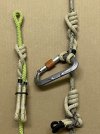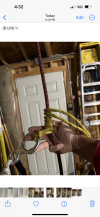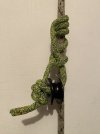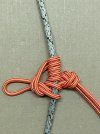Very cool hitch.Hey friends. I am hoping someone has a name or a prior @Brocky sketch or an opinion here. What do I have here? It's similar to the Agile Hitch in its construction but evenly loads both sets of strands off the top and into the bottom of the helix... in that light, it's similar to the Longhorn Agile... cuz I can break it under load. It self tends beautifully. It's completely compact and non jamming. And of course, we tune the # of wraps as necessary. I tied it starting with the cord inside the carabiner: 5 wraps upward, straight down and around the back (like Agile), then closed around the carabiner with a flat overhand bend, tied as compact as possible.
JrbTreeClimbing.com, affiliated with RockNArbor.com
I’m not the guy to ask if this already exists, but in keeping with the Agile naming convention, maybe this could be the Acrobat hitch, Trapeze hitch, something like that.
Pending confirmation that it doesn’t already exist…










